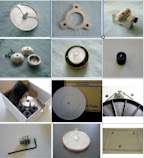A popular turntable in the 70's, Rega Planar 3 is more than thirty years old now. Leaving the age aside, it does not lose out to some of the new Regas in appearance and in performance. If we were to compare, we would find Planar 3 and the new models not only basically look similar, there's not much difference in design and construction other than the upgraded motor in later models.
Many analog enthusiasts today still regard Planar 3, with 18 mm diameter heavy duty main bearing housing, a good-sounding turntable and would rather restore or upgrade a Planar 3 than to get a new RP1, P1, P2 or even P3........ . If you have a Planar 3 or Planar 2 that's not modded, here's the tips for substantial sonic improvement with simple upgrades!
In this post I am going to show you step by step upgrades for a Rega Planar 3 turntable since I have received many enquires particularly on motor base upgrade for this turntable. I will also include all other possible mods for easy reference at a glance. Hope it would be helpful to those who are going for these Planar 3 tweaks.
i) Changing the pulley :

For most Planar turntables, the pulley which is glued down on the spindle is easily removed by hand as the glue has deteriorated over time.
Fix the stainless metal pulley ( standard or dual) after applying a bit of light oil on the spindle. Tighten the set screw with allen key.
ii) Removing the motor :
Unscrew the two black screws to loosen the motor mounting bracket. The motor which is held by rubber band to the bracket is now loosely cradled within the motor compartment by the back cover.
Now we need to overturn the turntable to work on the motor. Before doing so, make sure to :
i) remove the platter
ii) lock the tonearm.
iii) place a piece of cloth (or any soft material) of sufficient thickness on top of the the sub-platter to block the sub-platter and bearing from falling out when the turntable is turned over.
With the cloth in place, close the lid. Put the turntable upside down on the work place such that it rests on the lid.
(Put some newspapers or soft material on the surface of work place to prevent the plastic lid from being scratched.)
When turned upside down, the sub-platter stays in place together with and ball bearing. No messy mishaps like lubricating oil spills out or ball bearing goes missing.....
Open the motor compartment using a suitable screw driver.
Now you can see how the motor is held by elastic band to the plinth and what it's meant by the motor "sways (wobbles) with music" which results in speed inconsistency and affects the performance of the turntable.
Remove the motor mounting bracket and elastic band.
iii) Fixing the motor base and thrust bearing :
Bend the motor flange upwards using the pliers such that it is level with the top surface. No need to be perfect.
Before we go to the motor isolation base, snap in the thrust bearing to the bottom of the motor after adding two or three drops of light oil. It's simple (as shown in the picture).
Tape the motor wires with electrical insulating tape for insulation as well as preventing the motor vibration from reaching the board.
Place the motor onto the motor base and align the mounting holes of the motor flanges with the thread holes on the base. Use the screws provided to hold the motor tightly in place.
Remember to tighten the screws alternatively between the motor flanges to ensure even pressure being applied on both sides.
Use the plastic bracket and the screw to hold down the rubber mesh netting on one side first (next to the brass bearing housing) before putting back the motor base/motor.
Put the motor back to the motor compartment. Affix the cork stickers to the motor base as shown. Cover and secure the other side of the rubber mesh netting with plastic bracket and screw. The rubber mesh netting should be a bit slack (7-8 mm) such that in upright position, the motor is not touching the plinth and the pulley stays within the pulley hole when the turntable is lifted up .
Change the original rubber feet to the new taller ones as shown. You may use the original mounting screws .
Alternatively, you can upgrade to aluminium feet (à la P7/P9) using existing rubber feet for better turntable isolation.
Turn over the turntable now. Align the pulley in the centre of the hole making sure the whole assembly (pulley+motor+motor base) is not in contact with any part of the plinth.
The pulley grooves (and the belts) should aligned within +- 4 mm higher or lower from the centre of the sub-platter.
Fine adjustment in pulley height might be required to align the pulley with different types of sub-platters you used. Stainless steel or brass washers (50 mm( 2") x 2 mm) could be used between motor and motor base to adjust the height of pulley assembly if necessary.
Replacing the original resin sub-platter with anti-resonance aluminium metal sub-platter is a breeze. Remember to oil the stainless steel shaft with
suitable lubricant before inserting it into the brass bearing housing.
I am sure everyone knows what to do with this 24 mm acrylic platter.
 Loosen the tonearm cable clip and turn the adjustable spanner anti-clockwise to loosen the tonearm hexagonal nut in order to remove the RB300 tonearm.
Loosen the tonearm cable clip and turn the adjustable spanner anti-clockwise to loosen the tonearm hexagonal nut in order to remove the RB300 tonearm.
Remove the tonearm from board. Put the serrated 3-point spacer in place. Put back the tonearm and hand-tighten the nut(+1/4 turn). The serrated stainless steel spacer now semi-decouples the tonearm from board while enhancing the rigidity.
Step 4 : Sit back now and treat yourself to some wonderful music.......

Now you have a capable audiophile machine to enjoy beautiful analog music. It will sound as good as many more expensive models of turntables you find in the market!
Happy tweaking!
Dirk Lötsch of Hannover, Germany has tweaked his Planar 3 and he commented:
"Now, all the items (Motor base, dual pulley, silicone belts, aluminum feet and thrust bearing) are installed (takes about 1h) and it sounds fantastic (great mids and straighter bass)!"
|
Glen Nuckolls of Massachusetts, USA, has tweaked his P3-2000 and he commented:
"1) No more wow from the bend in the white belt.
2) Speed seems very stable. I have not been able to hear any "macro" pitch issues, meaning, to me, no audible pitch fluctuation. Basically no wow. I am no longer frustrated with records! I was getting to be quite good at hearing very subtle pitch fluctuations.
3) The turntable is more quiet and clear. It seems easier to hear and enjoy the music at both low and high volume levels. At higher levels, it's easier on the ears and at lower levels its easier to hear.
4) All the important musical stuff better: instrument timbre, attack, detail.
5) Sounds like I went up to a better class of turntable.
Overall, I'm very happy with the improvement and I think it was a good value for what I got. "
|

















































